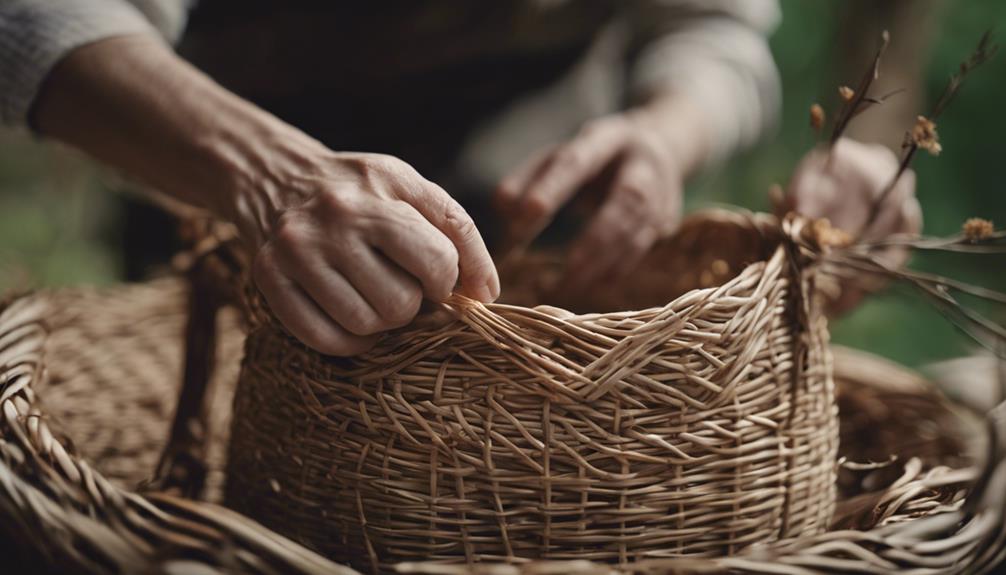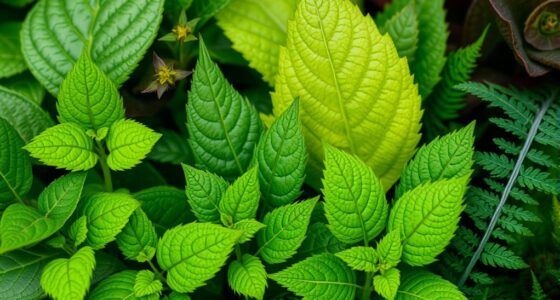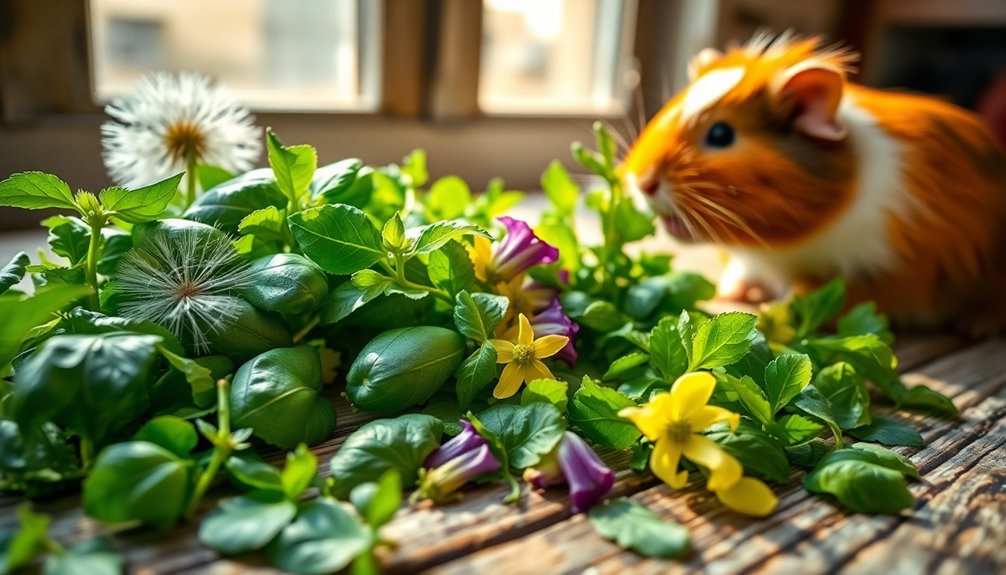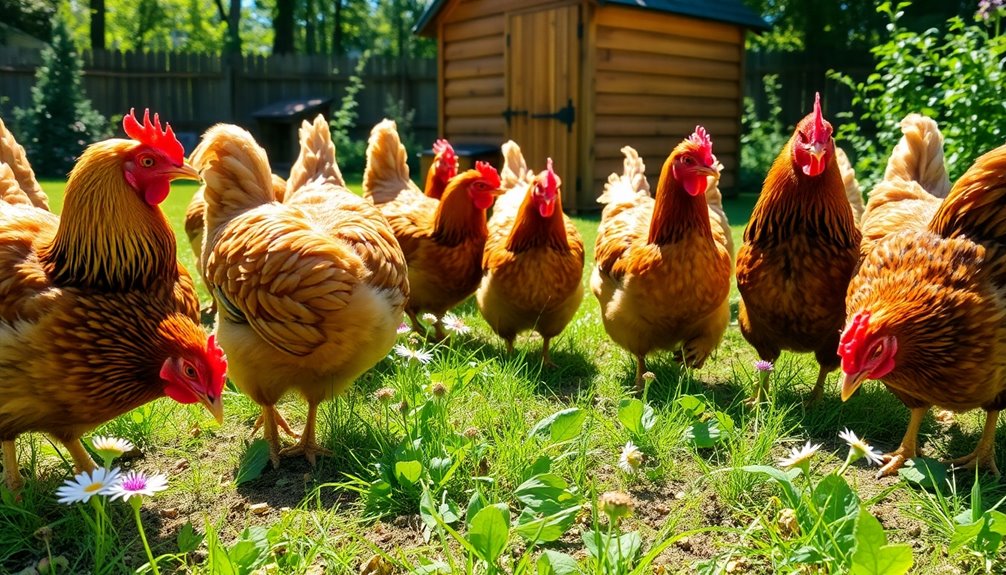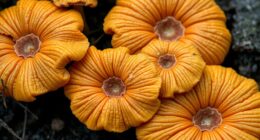To create your own foraging basket, select sturdy materials such as willow that offer both flexibility and strength. Locate plants that provide fibers, gather them in a sustainable manner, and soak the fibers to make them more pliable. Show your support for local ecosystems by responsibly harvesting and clearing away debris before beginning the weaving process. Enhance the uniqueness of your basket by adding shells, feathers, or beads, and experiment with different weaving techniques such as coil, woven, plaited, and twined basketry. Customize your creation with intricate patterns and a leather strap for easy transport. If you are looking to improve your basket weaving abilities, delving into various techniques, materials, and design aspects will assist you in crafting a top-notch foraging companion.
Key Takeaways
- Select durable materials like willow and wild grapes for weaving.
- Practice sustainable harvesting to preserve plant sources.
- Explore various weaving techniques for unique basket designs.
- Incorporate decorative elements like shells or beads for a personalized touch.
- Choose a handmade, sturdy wicker basket with ample dimensions for foraging.
Selecting the Right Basket Weaving Materials
When selecting materials for your foraging basket weaving project, ponder the versatility and durability of willow, grasses, rushes, invasive plants, wild grapes, daylilies, and irises.
Basket handles are an essential component to contemplate, as they not only provide functionality but also contribute to the overall aesthetics of your creation. Willow, known for its flexible and sturdy nature, is an excellent choice for crafting durable and reliable basket handles that can withstand the rigors of everyday use.
Grasses and rushes, with their inherent strength, can be woven intricately to form sturdy handles suitable for various weaving techniques like coil weaving. Invasive plants, besides aiding in population control, can also be utilized creatively to fashion unique and eco-friendly basket handles.
Wild grapes, daylilies, and irises offer strong and pliable materials that can be harvested and crafted into handles that add a touch of natural beauty to your foraging basket. Remember, the choice of material for your basket handles can greatly impact the functionality and aesthetic appeal of your final masterpiece.
Foraging for Natural Fibers
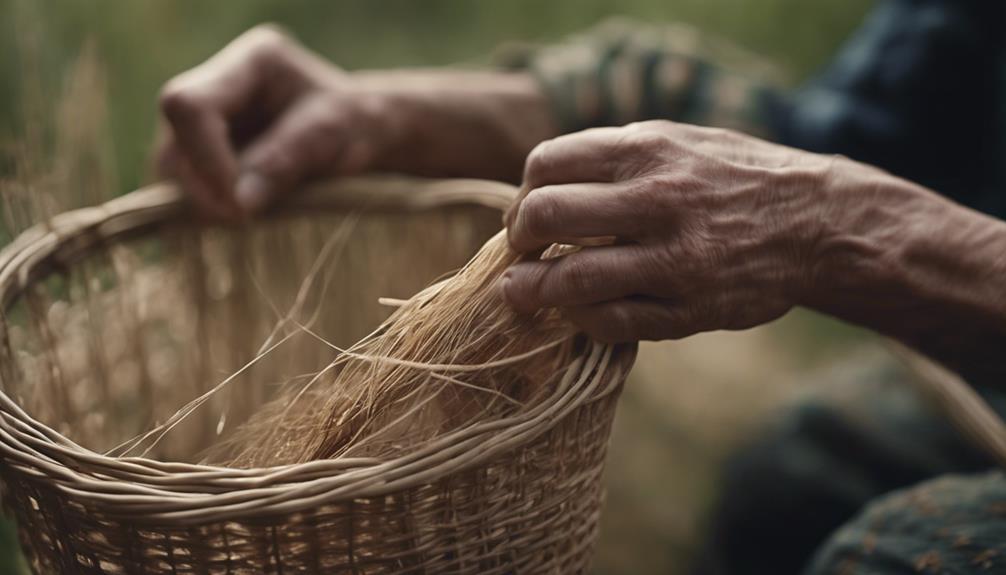
When foraging for natural fibers, your first step is to identify suitable plant sources like willow, grasses, rushes, and vines.
Practice sustainable harvesting by gently shaking plants to remove insects, taking only what you need, and leaving the majority untouched for future growth.
Once collected, process the fibers carefully to prepare them for weaving into your own unique foraging basket.
Identifying Plant Fiber
To identify suitable plant fibers for your foraging basket, look for plants with long, sturdy fibers like willow, grasses, and rushes. Confirm the plants are pliable and suitable for weaving by testing their flexibility. Consider the location and environment where the plants grow to identify the best natural fibers for your baskets. Learn to distinguish between different plant fibers to choose the most appropriate ones for your weaving projects. Use a plant identification guide to accurately recognize and gather the right materials for your foraging basket.
When scouting for plant fibers, keep an eye out for the following characteristics:
- Long and Sturdy Fibers: Opt for plants that offer long, durable fibers ideal for weaving.
- Flexibility Test: Assess the pliability of the fibers by gently bending them to make sure they're suitable for basket making.
- Environmental Considerations: Take into account where the plants are located and the conditions they grow in to select the most suitable fibers.
- Plant Identification Guide: Utilize a reliable guide to correctly identify different plant fibers and gather the appropriate materials for your weaving projects.
Sustainable Harvesting Methods
Consider utilizing ethical foraging practices when gathering natural fibers such as willow, grasses, and rushes for your basket weaving projects. Harvest only what you need, leaving the majority of plants untouched to guarantee sustainability and support local ecosystems. Invasive plant species can also serve as a sustainable source for weaving materials, aiding in controlling their populations. Opt for sturdy and pliable plants like wild grapes, daylilies, and irises for wild basketry projects that require strength and flexibility. Always shake harvested plants to remove any critters and use sharp tools like knives or pruners to minimize damage during harvesting.
| Sustainable Harvesting Methods for Wild Basketry | Key Points | Benefits |
|---|---|---|
| Harvest only what you need | Guarantees sustainability | Supports local ecosystems |
| Consider invasive plant species | Helps control populations | Utilizes available resources effectively |
| Opt for sturdy and pliable plants | Provides strength and flexibility | Creates durable baskets |
Processing Collected Fibers
To prepare the fibers you've collected for weaving, start by soaking them in water to make sure they become pliable. This process will help you work with the fibers more easily and achieve better weaving results. After soaking them, consider using a natural drying method like air-drying to preserve the integrity of the fibers. This gentle approach will maintain the natural qualities of the fibers without causing damage.
When processing collected fibers such as pine needles, remember to separate and organize them by type and length. This organization will make it easier for you to weave and create cohesive patterns in your projects. Additionally, take the time to remove any debris or unwanted materials from the fibers before starting the weaving process. Keeping your fibers clean will result in a more polished final product that showcases your craftsmanship.
Experimenting with different fiber combinations can lead to unique textures and patterns in your weaving projects, allowing you to express your creativity and individual style.
Essential Basket Weaving Techniques
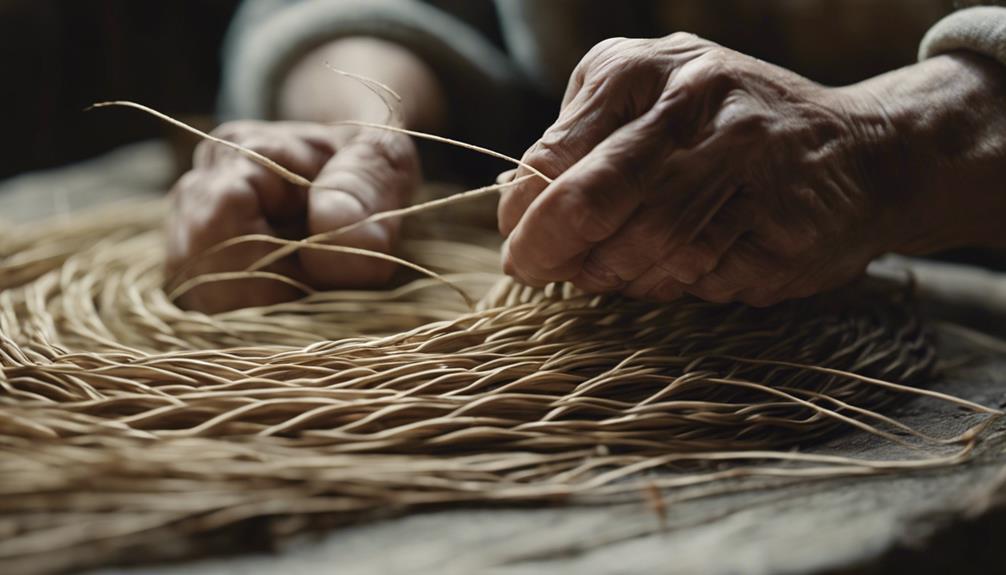
To master the art of basket weaving, you must grasp basic weaving methods like coil, woven, plaited, and twined basketry.
Understanding these techniques will help you create sturdy and intricate designs using materials like grasses, vines, and plant leaves.
Selecting the right materials is essential for achieving the desired strength, flexibility, and aesthetic appeal in your woven creations.
Basic Weaving Methods
When beginning your foraging basket weaving journey, mastering basic weaving methods is essential for creating sturdy and functional baskets. Understanding various techniques like coil basketry, woven basketry, plaited basketry, and twined basketry will allow you to craft beautiful and durable willow baskets. Here's a breakdown of these fundamental weaving methods:
- Coil Basketry: Involves coiling pliable plants like grasses and rushes to create sturdy baskets.
- Woven Basketry: Uses vines like bittersweet and grape to weave classic basket designs.
- Plaited Basketry: Utilizes bendable plant leaves such as cattails and grasses for weaving.
- Twined Basketry: Involves weaving with bendable plant leaves like cattails and iris leaves in a twining pattern.
Exploring these techniques through a basket weaving kit designed for beginners can help you discover your preferred style and method.
Practice and patience are key to mastering these basic weaving methods and creating your own unique foraging basket.
Material Selection Tips
Mastering the art of selecting suitable materials is essential for honing your basket weaving skills and creating functional foraging baskets. When choosing weaving materials, opt for pliable options like willow for their flexibility and strength, ideal for weaving baskets.
Grasses and rushes work well for coil weaving techniques, providing both sturdiness and flexibility in your projects. Consider incorporating invasive plant species into your weaving material selection to assist in controlling their populations while creating sustainable baskets.
Wild grapes offer robust materials with unique textures suitable for various weaving projects. For weaving leaves, daylilies and irises are excellent choices, particularly in forest margins, offering versatility and natural beauty in basketry.
Finishing Touches and Personalization

Consider adding a waterproof lining to protect your foraged goods from moisture, enhancing the functionality of your foraging basket.
Personalizing your basket can make it truly unique. Here are some ideas to help you add those finishing touches:
- Unique Colors and Patterns: Use different colored reeds or experiment with intricate weaving patterns to create a one-of-a-kind design.
- Decorative Elements: Incorporate shells, feathers, or beads into your weaving to add a touch of nature and personalize your basket.
- Comfortable Carrying: Attach a leather strap for easy portability or opt for a woven handle for added durability and style.
- Weaving Techniques: Explore weaving techniques like twill or checkerboard patterns to give your basket a distinctive look.
Mastering Traditional Weaving Methods

To advance your basket weaving skills, explore the traditional methods of coil, woven, plaited, and twined basketry. Each technique offers a unique approach to creating a finished basket.
Coil basketry involves wrapping pliable plants like grasses and rushes in a spiral fashion, resulting in a sturdy and durable structure.
Woven basketry, on the other hand, utilizes vines such as bittersweet and grape, weaving them over and under each other to form intricate patterns.
Plaited basketry involves weaving together bendable plant leaves like cattails and grasses in a checkerboard pattern, adding both strength and flexibility to the basket.
Finally, twined basketry employs materials like cattails and iris leaves twisted together to create a strong and visually appealing finished product.
Tips for a Functional Foraging Basket

When selecting a functional foraging basket, prioritize durability and ample dimensions to accommodate your foraged items effectively.
To guarantee you make an offer of the best basket, consider the following tips:
- Choose durable materials: Opt for a foraging basket made from sturdy materials like wicker to secure long-lasting use.
- Check dimensions: Look for a basket with generous dimensions, such as 30cm long, 26cm wide, and sides 15cm high, to accommodate your foraged items comfortably.
- Handmade craftsmanship: Consider a basket handwoven from Scottish willow for authentic craftsmanship and sustainability.
- Traditional design: Select a basket with a traditional frame design, as it's ideal for carrying various foraging essentials hassle-free.
Frequently Asked Questions
What Are the 4 Techniques of Basket Weaving?
You can explore four techniques of basket weaving: coil basketry using grasses, woven basketry with vines, plaited basketry using plant leaves, and twined basketry with twisted leaves. A beginner kit can help you start.
Is It Hard to Learn to Weave Baskets?
Learning to weave baskets isn't hard; it's a skill mastered through patience and practice. With beginner-friendly techniques like coil, plaited, and twined weaves, accessible resources, and dedication, you can gradually become a weaving expert.
What Does the Basket Weaving Symbolize?
Basket weaving symbolizes cultural heritage, patience, creativity, and unity. Different patterns and materials hold symbolic meanings. Finished baskets represent community and functionality. Learning these techniques fosters appreciation for handmade crafts and a sense of accomplishment.
What Is the Skill of Making Baskets Called?
Crafting baskets is like painting with nature's brush. The skill of making baskets is known as basket weaving or basketry. You interlace plant materials to create functional and decorative pieces, each reflecting unique traditions and styles.
Conclusion
To sum up, weaving your own foraging basket isn't just about creating a functional tool, but also about connecting with nature and preserving ancient traditions.
By mastering the art of basket weaving, you aren't only crafting a practical item, but also embracing a timeless skill that has been passed down through generations.
So, grab your materials and start weaving – let the ancient art of basketry guide you on a journey of creativity and connection with the natural world.

